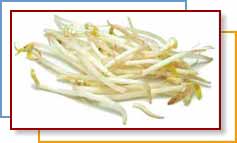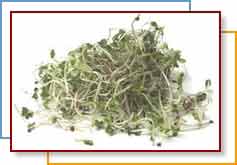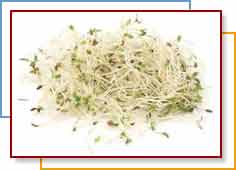Home | FOOD ARTICLES | Food Trivia | Today_in_Food_History | Food_History_Timeline | Recipes | Cooking_Tips | Food_Videos | Food_Quotes | Who’s_Who | Culinary_Schools_&_Tours | Food_Trivia_Quizzes | Food_Poems | Free_Magazines | Food_Festivals_and_Events
Food Articles, News & Features Section
FREE Magazines
and other Publications
Free Professional and Technical Research, White Papers, Case Studies, Magazines, and eBooks
SPROUTS
Sprouts are commonly seen at salad bars and supermarkets and each kind has its own unique flavor. Sprouts have a long history and were used for medicinal purposes in ancient China.
So what exactly classifies as a sprout? By definition it is a vegetable seed that just begins growing. Sprouts grow from the seeds of vegetables, grains, and various beans. They are the first edible shoots.
VARIETIES
Sprouts like other vegetables can vary in texture and taste. There are some that can add some spice to your meals like radish and onion sprouts. Hardy sprouts, like Mung bean sprouts, can withstand cooking. More delicate ones, like alfalfa sprouts, can be used in salads and sandwiches.
While not all varieties of sprouts are available at your local supermarket, try going to a farmer’s market to find other varieties.
 Bean Sprouts
Bean Sprouts
Commonly associated with the Mung beans, these sprouts have small light yellow leaves and a silvery white shoot. These sprouts produce a subtle nutty flavor and lots of crunch when added to stir-fries, soups, and salads.

Green-Leaf Sprouts
Typically germinated vegetable and grain seeds, these sprouts and are recognized by two tiny green leaves at the tip of a slender 1/2-inch to 3-inch shoot. These sprouts are often used in salads and sandwiches.

Alfalfa Sprouts
One of the most common sprouts on the market, these sprouts have threadlike shoots with green tops. They provide a subtle nutty flavor. A great addition to salads and sandwiches.
Radish Sprouts
Known as the "hot," these sprouts that evokes the zippy taste of radishes.
Sunflower Sprouts
Similar to alfalfa sprouts, sunflower sprouts have a mild, sweet flavor, adding crunch to any dish.
Pumpkin Sprouts
Grown from hulled seeds, these sprouts can be eaten raw or lightly toasted. Excellent when added to salads, soups and bread.
Wheat Sprouts
These sprouts cook quickly and are often used in recipes in place of whole grains.
Lentil Sprouts
Although not as ‘spicy’ as the Radish sprout, lentil sprouts have a peppery flavor. They are often used in soups, stews and casseroles.
SELECTION
Sprouts are fresh when they are crisp and their roots are moist and white. Avoid musty-smelling, dark, or slimy-looking sprouts.
STORAGE
Sprouts are highly perishable and should be eaten as soon as possible, but there are some ways to extend their shelf life. Most sprouts can be kept in a plastic bag in the crisper of the refrigerator for up to 3 days. Delicate sprouts like alfalfa should be refrigerated in the original ventilated plastic container. Rinsing daily under cold water may extend their life. Lastly, Mung bean sprouts can then be frozen if they are to be used for future cooking.
Sprouts and Food Safety
Because sprouts have associated with outbreaks of Salmonella and E.coli O157:H7 infection, people at high risk from exposure to these bacteria, such as children, the elderly, and people with weak immune systems, should avoid eating sprouts.
Sprouts are still an excellent way to increase your vegetable intake. Just take some precautions when choosing, storing, and preparing your sprouts:
-- Buy only fresh looking sprouts from a reputable store.
-- Keep sprouts refrigerated and use them promptly.
-- Wash the sprouts thoroughly with water to remove any dirt.
Make Sprouts Part of Your 5 A Day Plan 
-- Hardier sprouts like Mung bean and lentil sprouts tolerate heat and are often used in stir-fry dishes, soups, and stews.
-- Fresh sprouts make a great addition to salads, sandwiches, and wraps, and can also be used as a garnish.
-- Add a variety of different sprouts to your favorite coleslaw.
-- Try Mung bean or lentil sprouts in your potato salad for a different texture.
-- Include cabbage, Mung bean, or lentil sprouts in all your vegetable and fruit smoothies or blended juices for a tasty treat.
-- Sprouts like Mung bean and radish can be mixed with soft cheeses for a delicious dip.
-- Looking for a new sandwich spreads? Try pureeing lentil or radish sprouts with a teaspoon of fat free cream cheese.
-- Liven up your omelet or scrambled eggs with alfalfa, clover, or radish sprouts.
-- Many rice dishes taste great with a combination of fenugreek, lentil, or Mung bean sprouts.
-- Serve sprouts as side dishes! Try sautéing your favorite sprouts with onions, adding sprouts to baked beans, or pureeing sprouts with your favorite peas or beans.
RELATED ARTICLES
Please feel free to link to any pages of FoodReference.com from your website.
For permission to use any of this content please E-mail: james@foodreference.com
All contents are copyright © 1990 - 2025 James T. Ehler and www.FoodReference.com unless otherwise noted. All rights reserved.
You may copy and use portions of this website for non-commercial, personal use only.
Any other use of these materials without prior written authorization is not very nice and violates the copyright.
Please take the time to request permission.

